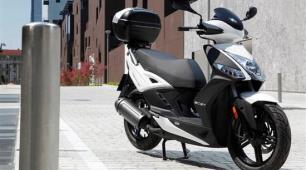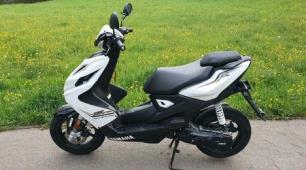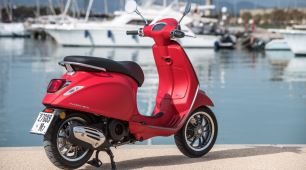 Yamaha aerox NS50 - Owner's Manual > Checking the front and rear brake pads
Yamaha aerox NS50 - Owner's Manual > Checking the front and rear brake pads
The front and rear brake pads must be checked for wear at the intervals specified in the periodic maintenance and lubrication chart.
Front brake pads

- Brake pad wear indicator groove
Each front brake pad is provided with a wear indicator groove, which allows you to check the brake pad wear without having to disassemble the brake.
To check the brake pad wear, check the wear indicator groove. If a brake pad has worn to the point that the wear indicator groove has almost disappeared, have a Yamaha dealer replace the brake pads as a set.
Rear brake pads

- Lining thickness
Check each rear brake pad for damage and measure the lining thickness. If a brake pad is damaged or if the lining thickness is less than 1 mm (0.04 in), have a Yamaha dealer replace the brake pads as a set.
Checking the brake fluid level
Before riding, check that the brake fluid is above the minimum level mark.
Check the brake fluid level with the top of the reservoir level. Replenish the brake fluid if necessary.

- Minimum level mark
Specified brake fluid: DOT 4
WARNING
Improper maintenance can result in loss of braking ability. Observe these precautions:
- Insufficient brake fluid may allow air to enter the brake system, reducing braking performance.
- Clean the filler cap before removing.
Use only DOT 4 brake fluid from a sealed container.
- Use only the specified brake fluid; otherwise, the rubber seals may deteriorate, causing leakage.
- Refill with the same type of brake fluid. Adding a brake fluid other than DOT 4 may result in a harmful chemical reaction.
- Be careful that water does not enter the brake fluid reservoir when refilling. Water will significantly lower the boiling point of the fluid and may result in vapor lock.
NOTICE
Brake fluid may damage painted surfaces or plastic parts. Always clean up spilled fluid immediately.
As the brake pads wear, it is normal for the brake fluid level to gradually go down. A low brake fluid level may indicate worn brake pads and/or brake system leakage; therefore, be sure to check the brake pads for wear and the brake system for leakage. If the brake fluid level goes down suddenly, have a Yamaha dealer check the cause before further riding.
Changing the brake fluid
Have a Yamaha dealer change the brake fluid at the intervals specified in the periodic maintenance and lubrication chart. In addition, have the brake hose replaced every four years or whenever it is damaged or leaking.
Checking and lubricating the throttle grip and cable
The operation of the throttle grip should be checked before each ride. In addition, the cable should be lubricated by a Yamaha dealer at the intervals specified in the periodic maintenance chart.
The throttle cable is equipped with a rubber cover. Make sure that the cover is securely installed. Even though the cover is installed correctly, it does not completely protect the cable from water entry. Therefore, use care not to pour water directly onto the cover or cable when washing the vehicle. If the cable or cover becomes dirty, wipe clean with a moist cloth.
Lubricating the front and rear brake levers

The pivoting points of the front and rear brake levers must be lubricated at the intervals specified in the periodic maintenance and lubrication chart.
Recommended lubricant: Silicone grease
Checking and lubricating the centerstand

- Centerstand
The operation of the centerstand should be checked before each ride, and the pivots and metal-to-metal contact surfaces should be lubricated if necessary.
WARNING
If the centerstand does not move up and down smoothly, have a Yamaha dealer check or repair it. Otherwise, the centerstand could contact the ground and distract the operator, resulting in a possible loss of control. Recommended lubricant: Lithium-soap-based grease
Checking the front fork
The condition and operation of the front fork must be checked as follows at the intervals specified in the periodic maintenance and lubrication chart.
To check the condition
Check the inner tubes for scratches, damage and excessive oil leakage.
To check the operation
1. Place the vehicle on a level surface and hold it in an upright position.
WARNING! To avoid injury, securely support the vehicle so there is no danger of it falling over.
2. While applying the front brake, push down hard on the handlebars several times to check if the front fork compresses and rebounds smoothly.

NOTICE
If any damage is found or the front fork does not operate smoothly, have a Yamaha dealer check or repair it.
Checking the steering
Worn or loose steering bearings may cause danger. Therefore, the operation of the steering must be checked as follows at the intervals specified in the periodic maintenance and lubrication chart.
1. Place the vehicle on the centerstand.
WARNING! To avoid injury, securely support the vehicle so there is no danger of it falling over.
2. Hold the lower ends of the front fork legs and try to move them forward and backward. If any free play can be felt, have a Yamaha dealer check or repair the steering.

Checking the wheel bearings

The front and rear wheel bearings must be checked at the intervals specified in the periodic maintenance and lubrication chart. If there is play in the wheel hub or if the wheel does not turn smoothly, have a Yamaha dealer check the wheel bearings.
Battery

- Fuse
- Battery
A poorly maintained battery will corrode and discharge quickly. The electrolyte level, battery lead connections and breather hose routing should be checked before each ride and at the intervals specified in the periodic maintenance and lubrication chart.
To check the electrolyte level
- Place the scooter on a level surface and hold it in an upright position.
TIP
Make sure that the scooter is positioned straight up when checking the electrolyte level.
2. Remove panel A.
3. Check the electrolyte level in the battery.

- Maximum level mark
- Minimum level mark
TIP
The electrolyte should be between the minimum and maximum level marks.
4. If the electrolyte is at or below the minimum level mark, add distilled water to raise it to the maximum level mark.
NOTICE: Use only distilled water, as tap water contains minerals that are harmful to the battery.
WARNING
Electrolyte is poisonous and dangerous since it contains sulfuric acid, which causes severe burns. Avoid any contact with skin, eyes or clothing and always shield your eyes when working near batteries. In case of contact, administer the following FIRST AID.
- EXTERNAL: Flush with plenty of water.
- INTERNAL: Drink large quantities of water or milk and immediately call a physician.
- EYES: Flush with water for 15 minutes and seek prompt medical attention.
Batteries produce explosive hydrogen gas. Therefore, keep sparks, flames, cigarettes, etc., away from the battery and provide sufficient ventilation when charging it in an enclosed space.
KEEP THIS AND ALL BATTERIES OUT OF THE REACH OF CHILDREN.
5. Check and, if necessary, tighten the battery lead connections and correct the breather hose routing.
To store the battery
1. If the scooter will not be used for more than one month, remove the battery, fully charge it, and then place it in a cool, dry place.
NOTICE: When removing the
battery, be sure the key is
turned to " ", then disconnect
the negative lead before disconnecting
the positive lead.
", then disconnect
the negative lead before disconnecting
the positive lead.
2. If the battery will be stored for more than two months, check the specific gravity of the electrolyte at least once a month and fully charge the battery whenever necessary.
3. Fully charge the battery before installation.
NOTICE: When installing
the battery, be sure the key
is turned to " ", then connect
the positive lead before connecting
the negative lead.
", then connect
the positive lead before connecting
the negative lead.
4. After installation, make sure that the battery leads are properly connected to the battery terminals and that the breather hose is properly routed, in good condition, and not obstructed.
NOTICE: If the breather hose is positioned in such a way that the frame is exposed to electrolyte or gas expelled from the battery, the frame could suffer structural and external damages.
See also:
 Yamaha aerox NS50 - Owner's Manual > Changing the coolant
Yamaha aerox NS50 - Owner's Manual > Changing the coolant
The coolant must be changed at the intervals specified in the periodic maintenance and lubrication chart. Have a Yamaha dealer change the coolant. WARNING! Never attempt to remove the radiator cap when the engine is hot.
 Yamaha aerox NS50 - Owner's Manual > Replacing the fuse
Yamaha aerox NS50 - Owner's Manual > Replacing the fuse
Fuse Battery The fuse holder is located behind panel A.
 BMW R 1250 RT
BMW R 1250 RT Kymco Agility 50
Kymco Agility 50 Piaggio Liberty 50
Piaggio Liberty 50 Yamaha aerox NS50
Yamaha aerox NS50 Aprilia SR50R
Aprilia SR50R Kymco Agility 50
Kymco Agility 50 Vespa Primavera 50
Vespa Primavera 50 Peugeot Speedfight
Peugeot Speedfight